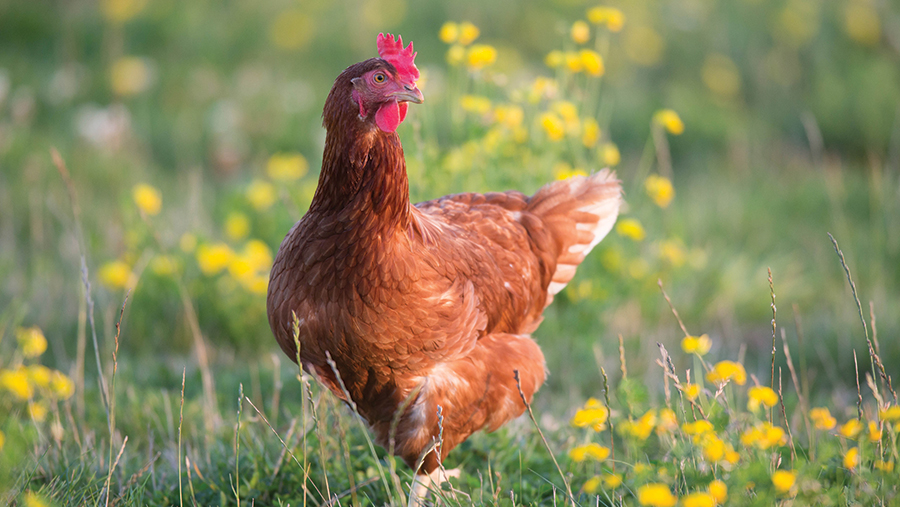4 key poultry management factors influencing egg size
 © Tim Scrivener
© Tim Scrivener Just over half of the eggs a hen lays over its lifetime will be classified as large or very large (weighing more than 63g) and retailers and shoppers have developed a taste for them in the past 18 months.
That demand has skewed the farmgate price for a dozen eggs, leaving farmers with up to 6p/doz less for medium over large, creating a strong incentive for producers to try to produce more large eggs.
It has become a major issue for the sector, so much so that the British Free Range Egg Producers Association has campaigned for consumers to choose more mixed-weight and medium packs.
See also: How to prevent heat stress in egg production
Beyond the simple fact that about 45% of eggs are medium or small, there are potential problems in pushing birds beyond their natural capacity for egg production.
There is also the risk of a range of health issues. At the less severe end is the potential for increased stress, feather loss or higher feed consumption, according to Crediton Milling poultry specialist Will White, and head of poultry at the firm, Russell Crang.

Pete Davis, Harriet Smith and Will White at Crediton Milling’s Devon HQ
Extreme cases where birds have been encouraged to lay large eggs can result in high rates of second-quality eggs and issues such as prolapsed oviducts as well as secondary problems such as egg peritonitis.
That’s why farmers must take a balanced approach to managing egg sizes, taking advantage of advice from nutritionists, genetics company reps and vets.
Before anything else is considered, if a flock is to perform at or above its breed standard for egg size, birds need to be in good health.
Here are four focus areas when aiming for the optimum egg size to suit both the market and your flock.
1. Genetics
Hens start to lay after reaching sexual maturity at about 19 weeks, and egg sizes naturally increase as birds age, in particular in the first 10-12 weeks of lay as they approach peak production at 25-26 weeks.
For example, a Lohmann Brown Classic has a rated cumulative egg weight of 42.9g at 20 weeks, rising to 63.5g at week 72.
Poultry genetics firms work hard to create breeds of bird that offer – as much as possible – consistent results when it comes to egg numbers and sizes based on market requirements.
Most breeds serving the UK market have historically been geared towards producing a large number of medium eggs, and so are not necessarily suited to the demand for fewer large eggs.
“In the ideal world you follow exactly what the breeding company recommends,” says Mr White.
“As soon as you step outside of its best advice, which is where birds want to be naturally, you have the potential to run into problems.”
The trouble is that it takes time to breed new characteristics into birds, so genetics companies have been playing catch-up with the market.
Despite that, most brands that serve the UK market have now introduced a hen geared towards producing larger egg sizes.
For example, the Hy-Line Brown Plus is marketed at producing eggs up to 2g heavier than the Hy-Line Brown.
2. Rearing
Management during rear can have the most significant influence on egg size later on, when the birds are in lay.
A farmer who wishes to target egg weight as a priority must let his pullet-rearing company know before his birds have been hatched.
The basic principle is to delay the onset of egg production. This allows birds to mature more slowly and develop a higher bodyweight.
“That way, egg sizes are larger when they come into lay and remain larger throughout the life of the flock,” says Mr White.
This is typically done by adjusting lighting regimes. Pullets start with 20 hours of light a day, which is reduced over the first weeks. If the lighting is lowered more slowly, birds will develop at a slower pace.
For example, the H&N Brown breed guidelines suggest a gradual reduction from 23 to 13 hours light over the first 11 weeks in the rearing shed to encourage larger eggs.
At the other end, birds after transfer at 16 weeks should be gradually exposed to longer lighting cycles to slow the onset of lay further and allow time for proper muscular and skeletal development.
3. Diet in early lay
Hens are fed a high-spec diet in their first weeks in the laying house. “At 16 weeks you’ve got a bird with a range of demands – maintenance, further growth and the beginning of egg production,” Mr White says.
As a result, diets are formulated with a higher quality protein profile and better specification than in the rearing ration, and calcium levels are ramped up to help with skeletal growth and build up a reserve before egg-laying commences.
Birds typically increase their bodyweight by about 50% in their first 10 weeks on the laying farm, demonstrating the importance of a good diet.
From there it is a careful balance to get egg sizes right, explains Mr White. “You don’t want egg sizes to get too far from the natural growth of the breed target curve.”
At this stage, it is vital to monitor the birds’ condition and bodyweights, and be ready to adjust diets if necessary. It is important to note there is no fixed guidance for when to switch diets, and decisions should be taken on a flock-by-flock basis.
If egg sizes are deemed to be becoming too high, then hens will be switched to a ration with the same energy, but a different protein profile.
Lysine and methionine are two micro-ingredients that have a significant effect on controlling egg size and will be reduced gradually over the life of the hen.
But it is essential to take care, as adjusting the amino acid profile can also cause egg numbers to drop.
“You’ve got to be careful that, when you step down the diets to address egg size, you don’t lose production,” says Mr Crang.
“In a similar vein, calcium doesn’t make diets more palatable, so you have to be careful with its content. The birds can only absorb so much.”
4. End of lay
As birds age, egg sizes naturally increase, but shell quality can diminish. With producers hoping to keep birds in lay beyond 72 weeks, which until recently was the standard, maintaining bird health becomes even more important.
A range of nutritional supplements can support shell quality; oyster shell as a quality source of calcium has been used for many years.
More recently, a variety of specialist products have become available, such as Pidolin, from Agrosom, or products in Alltech’s Total Replacement Technology (TRT) range.
Crediton Milling, in Crediton, Devon, is a specialist feed mill producing feed for cattle, sheep and poultry
